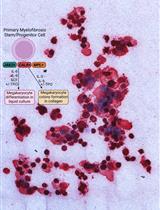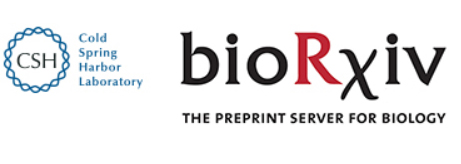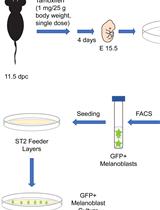- EN - English
- CN - 中文
Collagenase-based Single Cell Isolation of Primary Murine Brain Endothelial Cells Using Flow Cytometry
利用流式细胞技术进行原代小鼠脑内皮细胞的基于胶原酶的单细胞分离
发布: 2018年11月20日第8卷第22期 DOI: 10.21769/BioProtoc.3092 浏览次数: 12858
评审: Pengpeng LiAlak MannaAnonymous reviewer(s)

相关实验方案

来自骨髓增生性肿瘤患者的造血祖细胞的血小板生成素不依赖性巨核细胞分化
Chloe A. L. Thompson-Peach [...] Daniel Thomas
2023年01月20日 2295 阅读
Abstract
The brain endothelium is a highly specialized vascular structure that maintains the activity and integrity of the central nervous system (CNS). Previous studies have reported that the integrity of the brain endothelium is compromised in a plethora of neuropathologies. Therefore, it is of particular interest to establish a method that enables researchers to investigate and understand the molecular changes in CNS endothelial cells and underlying mechanisms in conjunction with murine models of disease. In the past, approaches to isolate endothelial cells have either involved the use of transgenic reporter mice or suffered from insufficiently pure cell populations and poor yield.
This protocol here is based on well-established protocols that were modified and combined to allow single cell isolation of highly pure brain endothelial cell populations using fluorescence activated cell sorting (FACS). Briefly, after careful removal of the meninges and dissection of the cortex/hippocampus, the brain tissue is mechanically homogenized and enzymatically digested in two steps resulting in a single cell suspension. Cells are stained with a cocktail of fluorochrome-conjugated antibodies identifying not only brain endothelial cells, but also potentially contaminating cell types such as pericytes, astrocytes, and lineage cells. Using flow cytometry, cell populations are separated and sorted directly into either RNA lysis buffer for bulk RNA analyses (e.g., RNA microarray and RNA-Seq) or in pure fetal bovine serum to preserve viability for other downstream applications such as single cell RNA-Seq and Assay for Transposase-Accessible Chromatin using sequencing (ATAC-Seq). The protocol does not require the expression of a transgene to label brain endothelial cells and thus, may be applied to any mouse model. In our hands, the protocol has been highly reproducible with an average yield of 3 x 105 cells from a pool of four adult mice.
Background
The brain endothelium serves as an interface for systemic factors circulating through the blood. Cerebral capillary endothelial cells constitute the blood-brain barrier (BBB), a physical barrier that limits paracellular flux via unique tight junction protein formations interconnecting cells, to maintain homeostasis of the neuronal environment and thus, neuronal functionality (Liebner et al., 2011 and 2018). The BBB not only limits the passage of ions and other molecules such as glucose but also prevents uncontrolled exchange of toxins, bacteria, viruses and cells between the blood and the brain parenchyma (Abbott et al., 2010). To accomplish this task, the brain endothelium is dependent on a fine-tuned microenvironment within the neuro-vascular unit (NVU), which consist of endothelial cells with closely associated pericytes and astrocytes as well as extracellular matrix components and microglia (Abbott and Friedman, 2012).
The function and/or integrity of the BBB is compromised in several neuropathologies, such as Alzheimer’s disease (AD), multiple sclerosis, epilepsy, and glioblastoma (Zlokovic, 2008; Marchi et al., 2012; Wolburg et al., 2012). The fluorescent activated cell sorting (FACS) single cell isolation method described here has been developed in the context of a study of transcriptional changes in brain endothelial cells in AD and inflammation (unpublished). It is a modification of published protocols for brain endothelial cell cultivation (Liebner et al., 2008; Czupalla et al., 2014), and is designed to dissociate brain EC into a single cell suspension while preserving many endothelial surface antigens for flow cytometry. We have successfully applied the method in a collaborative investigation of the effects of an aged systemic milieu on hippocampal neurogenesis and microglia activation and the role of vascular cell adhesion molecule 1 (VCAM-1) as a negative regulator of adult neurogenesis and inducer of microglial activity (Yousef et al., 2018a). For an alternative brain endothelial cell isolation protocol–slightly faster, but utilizing less gentle enzymatic digestion–see Yousef et al. (2018b).
In the last decade, several protocols for brain endothelial isolation have been employed predominantly in BBB developmental studies (Daneman et al., 2010; Vanlandewijck et al., 2018). However, these techniques are dependent on the presence of transgenic endothelial cell markers and thus, may not easily be applied to transgenic disease mouse models. In addition, depending on the digestion enzyme used, epitopes essential for brain endothelial cell detection, such as CD31 are destroyed. This protocol allows the isolation of highly pure brain endothelial cell population (and pericytes) from any mouse strain or murine animal model using gentle enzymatic digestion steps that preserve endothelial-specific epitopes.
Materials and Reagents
- Falcon 15 ml conical centrifuge tubes (Fisher Scientific, Corning, catalog number: 352096)
- Falcon 50 ml conical centrifuge tubes (Fisher Scientific, Corning, catalog number: 352070)
- Bottle-top vacuum filters, pore size 0.45 μm (MilliporeSigma, Corning, catalog number: CLS430514-12EA)
- Bottle-top vacuum filters, pore size 0.22 μm (MilliporeSigma, Corning, catalog number: CLS430513-12EA)
- Disposable sterile bottles (Fisher Scientific, Corning, catalog number: 09-761-10)
- 1.5 ml Snap-Cap Microcentrifuge Safe-LockTM Tubes (Eppendorf, catalog number: 022363204)
- 1 ml Insulin Syringe with Slip Tip (BD, catalog number: 329654)
- 1 ml Millex-GV Filter, 0.22 µm (MilliporeSigma, catalog number: SLGV004SL)
- Petri Dish 100 x 21 mm (Thermo Fisher Scientific, NuncTM, catalog number: 172931)
- Petri Dish 60 x 15 mm (Thermo Fisher Scientific, NuncTM, catalog number: 150326)
- Serological pipette 10 ml, sterile (SARSTEDT, catalog number: 86.1254.025)
- Optional: 5 ml conical tubes (Eppendorf, catalog number: 0030119487) (see Notes)
- Serological pipette 5 ml, sterile (SARSTEDT, catalog number: 86.1253.025)
- 5 ml Test Tube with Cell Strainer Snap Cap (Falcon, catalog number: 352235)
- Disposable Borosilicate Glass Pasteur Pipets, autoclaved (Fisher Scientific, catalog number: 13-678-20C)
- Screw-Cap microcentrifuge tubes, 1.5 ml (VWR, catalog number: 89004-290)
- Glass or plastic Beaker, 1,000 ml and 200 ml (laboratory specific)
- Autoclaved WhatmanTM qualitative filter paper, Grade CF 12 (Sigma-Aldrich, catalog number: WHA10535097) (see Notes)
- WhatmanTM Grade 1573-1/2 Qualitative Filter Papers (GE Healthcare, catalog number: 09-927-210)
- Disposable scalpel blades, sterile (IntegraTM Miltex®, catalog number: 4-123)
- Adult mice, 6-12 weeks, e.g., C57/Bl6 (The Jackson Laboratory, catalog number: 000664)
- Deionized, filtered water (dH2O) (Merck Millipore, Milli-Q)
- Bovine Serum Albumin, Fraction V, Heat Shock Treated (BSA) (Fisher Scientific, Fisher BioReagentsTM, catalog number: BP1600-1)
- Sodium chloride (NaCl) (MilliporeSigma, catalog number: S3014)
- Potassium chloride (KCl) (MilliporeSigma, catalog number: PX1405)
- Calcium chloride (CaCl2) (MilliporeSigma catalog number: 102391)
- Magnesium chloride (MgCl2) (MilliporeSigma catalog number: M8266)
- HEPES (Thermo Fisher Scientific, GibcoTM, catalog number: 15630080)
- Sodium hydroxide (NaOH), pellets (MilliporeSigma catalog number: S8045)
- Water, Molecular Biology Reagent (MilliporeSigma, catalog number: W4502-1L)
- Ethanol 70% W/V (MilliporeSigma, catalog number: EX0281-1)
- Red Blood Cell Lysis Buffer (MilliporeSigma, catalog number: 11814389001)
- Sodium phosphate monobasic (NaH2PO4) (MilliporeSigma, catalog number: S3139)
- Potassium phosphate dibasic (KH2PO4) (MilliporeSigma, catalog number: S3264)
- Fetal Bovine Serum (FBS), Defined (HyCloneTM, catalog number: SH30070.03)
- Hanks' Balanced Salt Solution (HBSS) (Thermo Fisher Scientific, GibcoTM, catalog number: 24020117)
- CD31 (PECAM-1) Monoclonal Antibody (390), PE-Cyanine7 (eBioscience, catalog number: 25-0311-82)
- MECA-99 (Eugene C. Butcher Laboratory) (Kruse et al., 1999; Lee et al., 2014)
- DyLightTM 488 Antibody Labeling Kit (Thermo Fisher Scientific, catalog number: 53024)
- Aminopeptidase N/CD13 Antibody (ER-BMDM1) (NOVUS Biologicals, catalog number: NB100-64843)
- ACSA-2 (Miltenyi, catalog number: 130-097-674)
- Anti-ACSA-2-PE, mouse (Miltenyi, catalog number: 130-102-365)
- Anti-Mouse CD45 PerCP-Cy5.5 (eBioscience, catalog number: 45-0451-82)
- Anti-mouse CD11a/CD18 (LFA-1) PerCP/Cy5.5 (BioLegend, catalog number: 141008)
- Anti-Mouse CD11b PerCP-Cyanine5.5 (eBioscience, catalog number: 45-0112-80)
- Anti-Mouse TER-119 PerCP-Cyanine5.5 (eBioscience, catalog number: 45-5921-82)
- UltraComp eBeadsTM (eBioscience, catalog number: 01-2222-42)
- Propidium iodide solution (PI) (MilliporeSigma, catalog number: P4864)
- Optional: RNeasy Plus Micro Kit (50) (QIAGEN, catalog number: 74034)
- Optional: Array, Mouse Gene 1.0 ST ARRAY (Affymetrix, catalog number: 901169)
- Collagenase type II (Biochrom Kg, catalog number: C2-22)
- Collagenase/Dispase (MilliporeSigma, catalog number: 11097113001)
- Deoxyribonuclease I (CellSystems, catalog number: LS006331)
- Stock solutions (see Recipes)
- PBS for BSA (see Recipes)
- Endothelial cell buffer (see Recipes)
- Collagenase II solution (see Recipes)
- 25% BSA (see Recipes)
- Collagenase/Dispase solution (see Recipes)
- DNase I solution (see Recipes)
- FACS Buffer (see Recipes)
- Antibody dilutions (see Recipes)
Equipment
- Scale and weigh supplies (Laboratory-specific)
- DURAN® Erlenmeyer flask, 2,000 ml (DURAN, catalog number: 21 216 63)
- -20 °C freezer (laboratory-specific)
- Precision GP 10 L General Purpose Water Bath (Precision Scientific, catalog number: TSGP10)
- Portable Pipet-Aid® XP Pipette Controller (DRUMMOND, catalog number: 4-000-101)
- Thermo ScientificTM NalgeneTM Polypropylene Powder Funnels (Thermo ScientificTM, catalog number: 42520150)
- Cylinder, Cylinder, Grad. Cls B, 1,000 ml and 100 ml
- Magnetic Stirrer (Thermo Fisher Scientific, catalog number: 90-691-18)
- FisherbrandTM Round Stir Bars with Removable Pivot Ring (Thermo Fisher Scientific, fit size to measure column)
- FisherbrandTM accumetTM AB15 Basic and BioBasicTM pH/mV/°C Meters or other pH meter
- Autoclave (laboratory-specific)
- Carbon dioxide chamber (laboratory-specific)
- Thermo-isolated container including a lid, filled with ice
- Surgical Scissors, Sharp (Fine Science Tools, catalog number: 14002-16)
- Fine Scissors, Blunt-Blunt (Fine Science Tools, catalog number: 14108-09)
- Semken Forceps, Straight (Fine Science Tools, catalog number: 11008-13)
- GSC Go Science Crazy Stainless-Steel Spatula (Fisher Scientific, catalog number: S50788A)
- Dumont #3 Forceps (Fine Science Tools, catalog number: 11293-00)
- Dumont #5–Ceramic Coated Forceps (Fine Science Tools, catalog number: 11252-50)
- Scalpel Handle #4 (Fine Science Tools, catalog number: 10004-13)
- Vacuum pump (laboratory-specific)
- Centrifuge 5810 R swing bucket for conical tubes (Eppendorf, model: 5810 R)
- PIPETMAN Classic P2 (Gilson, catalog number: F144801)
- PIPETMAN Classic P10 (Gilson, catalog number: F144802)
- PIPETMAN Classic P100 (Gilson, catalog number: F123615)
- PIPETMAN Classic P200 (Gilson, catalog number: F123601)
- PIPETMAN Classic P1000 (Gilson, catalog number: F123602)
- 4 °C fridge (laboratory-specific)
- Nikon SMZ 745, Stereomicroscope (Nikon, model: SMZ 745)
- BD FACSAriaTM II or III cell sorter (BD Biosciences)
Software
- BD FACSDIVATM SOFTWARE (BD Biosciences, version: V8.0.1)
- FlowJoTM (© FlowJo, LLC, version: 9.9.4 or higher)
- Optional: GeneSpring GX (Agilent Technologies, version: 14.8)
- Optional: Partek® Genomics Suite® (Partek Incorporated)
Procedure
文章信息
版权信息
© 2018 The Authors; exclusive licensee Bio-protocol LLC.
如何引用
Czupalla, C. J., Yousef, H., Wyss-Coray, T. and Butcher, E. C. (2018). Collagenase-based Single Cell Isolation of Primary Murine Brain Endothelial Cells Using Flow Cytometry . Bio-protocol 8(22): e3092. DOI: 10.21769/BioProtoc.3092.
分类
神经科学 > 细胞机理 > 细胞分离和培养
细胞生物学 > 细胞分离和培养 > 细胞分离 > 流式细胞术
您对这篇实验方法有问题吗?
在此处发布您的问题,我们将邀请本文作者来回答。同时,我们会将您的问题发布到Bio-protocol Exchange,以便寻求社区成员的帮助。
Share
Bluesky
X
Copy link










